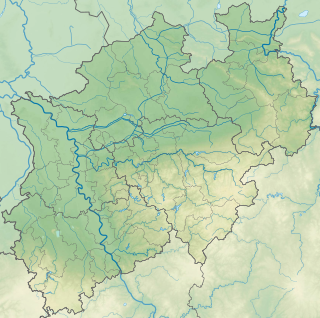Bechener plateau
| Bechener plateau | |||
|---|---|---|---|
| Systematics according to | Handbook of the natural spatial structure of Germany | ||
| Greater region 1st order | Low mountain range threshold | ||
| Greater region 2nd order | Rhenish Slate Mountains | ||
| Main unit group | 33 → Süderbergland |
||
| About main unit | 338 → Bergische plateaus |
||
| 4th order region (main unit) |
338.2 → Südbergische Plateau |
||
| Natural space |
338.21 → Bechen plateau |
||
| Geographical location | |||
| Coordinates | 51 ° 2 '25 " N , 7 ° 12' 35" E | ||
|
|||
| local community | Kürten , Odenthal , Wermelskirchen | ||
| state | North Rhine-Westphalia | ||
| Country | Germany | ||
The Bechener plateau is according to the Handbook of the Natural Region Divisions of Germany a natural spatial unit with the number 338.21 and is one of the superior natural environment 338.2 ( Südbergische plateau ). It includes the northwestern part of Kürten near the eponymous district of Bechen , the extreme southwest of the Wermelskirchen district of Dabringhausen and the Great Dhünntalsperre and the east of Odenthal .
The Bechener high surface lies, by the Dhünntal Valley separated, south of the Dhünn plateau (atomic number 338.20), rises in the east in the field of national road 506 in the Kürtener plateau (338,220) over and falls to the south about the course of running on a ridge Bundesstrasse 506 following in the Paffrath limestone sink (338.23). In the west are the Burscheider Lößterrassen (338.00), the Untere Dhünntal (550.05) and the Schildgener Heideterrasse (550.032).
The natural area, whose plateau character is still well preserved due to the low density of the valley network, rises in the west from the Dhünn (185 m) to the east to a height of almost 260 m. The valley, which is up to 100 m deep, is that of the Scherfbach , which divides the plateau into two unequal wings. The dominant rocks are slate and sandstones with small, subordinate limestone clods . Above this, in the west and south of the plateau, a patchy loess soil of varying thickness covers the subsoil. Otherwise, medium-sized stony or sandy loam soils prevail. The plateau is visibly and productively used agriculturally and is also largely forested.
